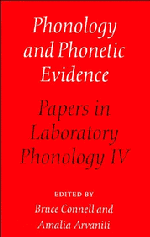Book contents
- Frontmatter
- Contents
- List of contributors
- Acknowledgments
- 1 Introduction
- I Features and Perception
- 2 Intermediate properties in the perception of distinctive feature values
- 3 A double-weak view of trading relations: comments on Kingston and Diehl
- 4 Speech perception and lexical representation: the role of vowel nasalization in Hindi and English
- 5 Processing versus representation: comments on Ohala and Ohala
- 6 On the status of redundant features: the case of backing and rounding in American English
- 7 The perceptual basis of some sound patterns
- II Prosody
- III Articulatory Organization
- Subject index
- Index of names
- Index of languages
6 - On the status of redundant features: the case of backing and rounding in American English
Published online by Cambridge University Press: 03 May 2011
- Frontmatter
- Contents
- List of contributors
- Acknowledgments
- 1 Introduction
- I Features and Perception
- 2 Intermediate properties in the perception of distinctive feature values
- 3 A double-weak view of trading relations: comments on Kingston and Diehl
- 4 Speech perception and lexical representation: the role of vowel nasalization in Hindi and English
- 5 Processing versus representation: comments on Ohala and Ohala
- 6 On the status of redundant features: the case of backing and rounding in American English
- 7 The perceptual basis of some sound patterns
- II Prosody
- III Articulatory Organization
- Subject index
- Index of names
- Index of languages
Summary
Introduction: enhancement features
Stevens, Keyser, & Kawasaki (1986) lay out a theory of phonological features in which languages employ features from a universal set in two different ways. Each language employs some features from this set to minimally distinguish lexical items; this is a distinctive use of the feature. Cases often arise in which a particular feature is never employed all by itself to contrast lexical items, but rather, it always occurs in conjunction with another, distinctive, feature. For reasons of compactness of description, various linguists, e.g. Halle (1958, 1964), have proposed that, at some level of the linguistic grammar, only one of the features needs to be specified. The other of the two features is redundant, and can thus be filled in by rule.
While the phonological literature on redundancy of featural specifications is quite large, there has been relatively little consideration of these phonologically based distinctions in feature usage from a phonetic standpoint. Stevens et al add the phonetic property of variability to the phonological, informationally based diagnostic of redundant and distinctive features. They state that, while distinctive features serve directly to convey lexical distinctions, redundant features serve to enhance the salience of the distinctive features. Thus, an alternative term for redundant features is enhancement features. As a corollary to this claim, they suggest that distinctive features are invariantly present in speech, while enhancement features are more variable, being employed especially in situations where the distinctive feature may be obscured by some attribute of the context in which the feature appears.
- Type
- Chapter
- Information
- Phonology and Phonetic EvidencePapers in Laboratory Phonology IV, pp. 68 - 86Publisher: Cambridge University PressPrint publication year: 1995
- 5
- Cited by

